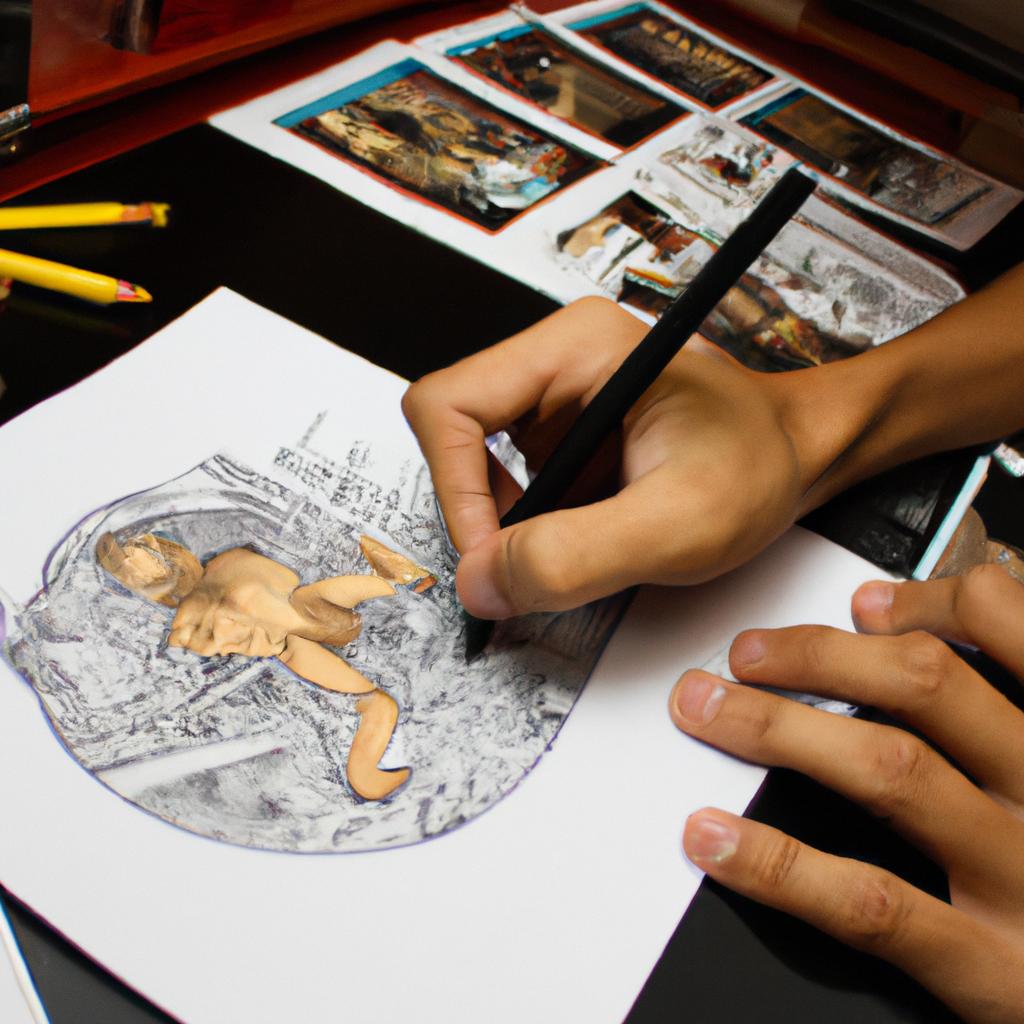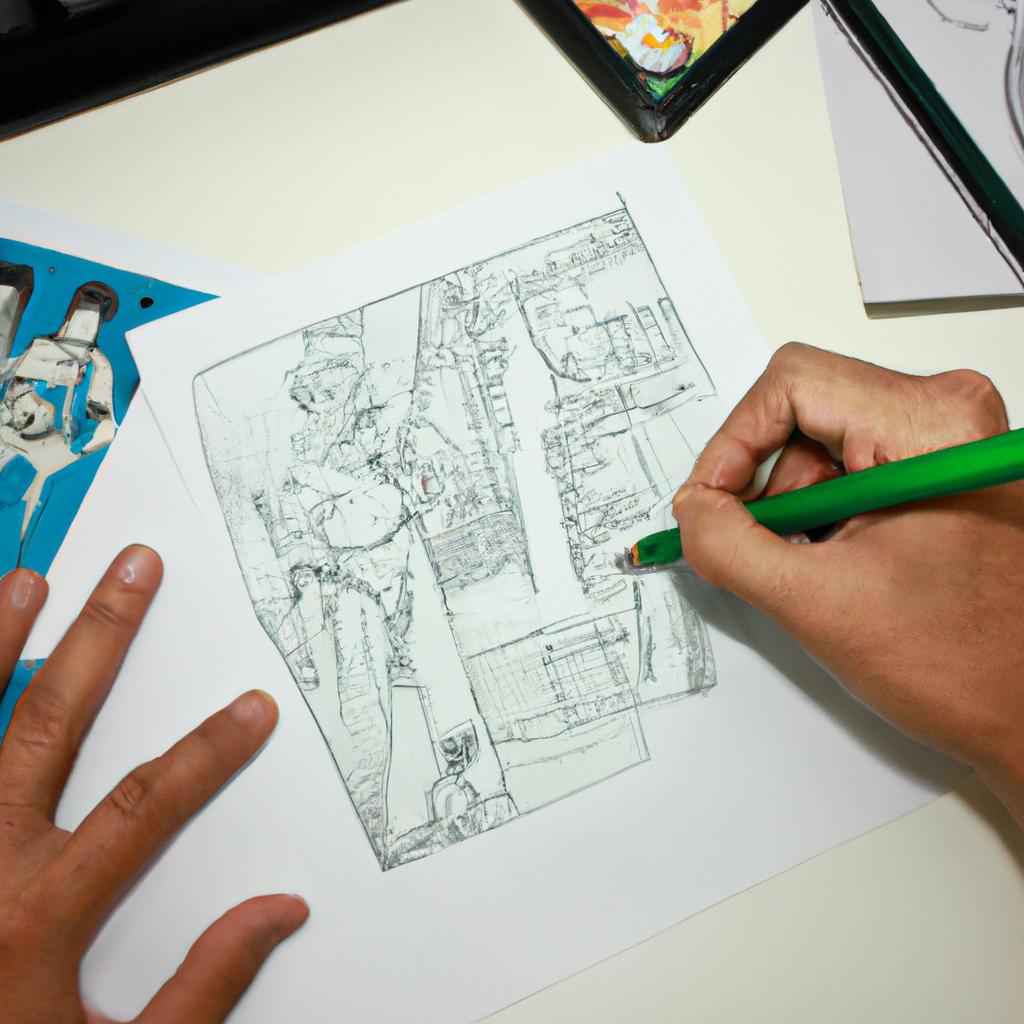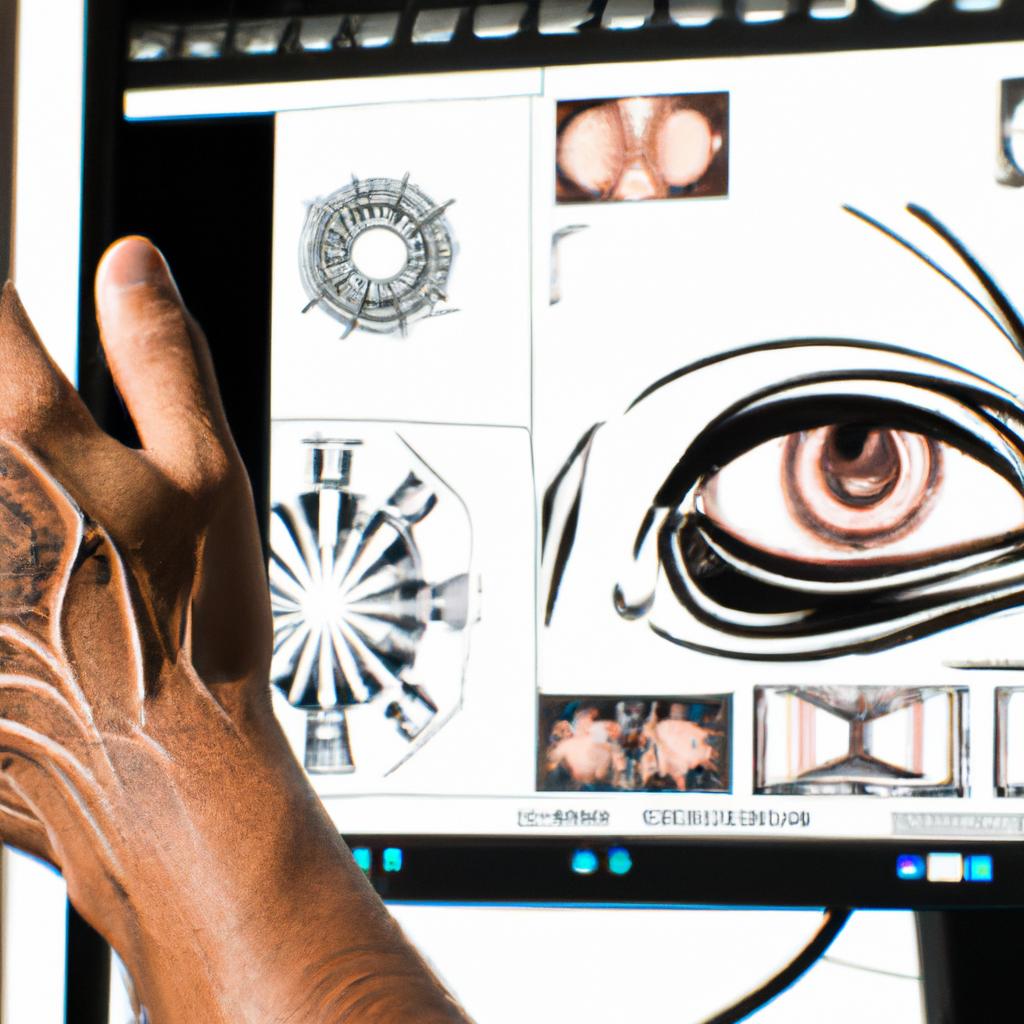Cover art plays a significant role in the world of comic book art, both aesthetically and in terms of impact. The cover serves as the initial point of contact for readers, enticing them to pick up a particular issue or series. It acts as a visual representation of the narrative contained within, encapsulating its essence and drawing potential readers into its world. For example, consider the case study of “The Amazing Spider-Man #1” released in 1963, which featured an iconic cover by artist Jack Kirby depicting Spider-Man swinging through New York City. This dynamic image not only captured the attention of comic book enthusiasts but also introduced the character to new audiences, contributing to the enduring popularity and longevity of Spider-Man.
Examining cover art from an aesthetic perspective reveals various elements at play that contribute to its overall impact. Artists utilize composition, color palette, line work, and typography strategically to create visually captivating images that convey mood, story elements, and character dynamics. Through skillful design choices and artistic craftsmanship, covers can evoke emotions such as excitement, suspense, or curiosity before even delving into the contents of the comic itself. Moreover, they often employ symbolism or clever visual storytelling techniques that provide subtle hints about what lies within the pages while maintaining an air of mystery and intrigue.
In addition to aesthetics, cover art also serves practical purposes. It helps to establish brand recognition and differentiate one comic series from another. Consistent branding elements, such as logo placement or recurring design motifs, enable readers to easily identify their favorite titles on the shelves amidst a sea of other options. Furthermore, cover art often features prominent characters or key plot moments that act as selling points for potential readers. These eye-catching visuals serve as a promise of the exciting adventures that await within the pages and can influence purchasing decisions.
Cover art has evolved over time alongside advancements in technology and changes in artistic trends. From hand-drawn illustrations to digitally rendered images, artists now have access to a wide range of tools and techniques to bring their visions to life. Additionally, with the rise of variant covers and special editions, cover art has become an avenue for artistic experimentation and creative expression beyond the confines of traditional storytelling.
Overall, cover art is an integral part of the comic book industry, playing a crucial role in attracting readership, establishing brand identity, and setting expectations for the narrative contained within. Its ability to captivate audiences through visual storytelling demonstrates its enduring significance in the world of comic book art.
Evolution of Cover Art in Comic Books
Comic books have long been known for their visually striking and captivating cover art, which serves as the gateway to the narratives contained within. Over the years, cover art has undergone a significant evolution, both in terms of its aesthetics and its impact on readership. To illustrate this point, let us consider the case study of “The Amazing Adventures of Superhero X,” a popular comic book series that spans several decades.
In its early days, “The Amazing Adventures of Superhero X” featured simplistic cover designs with bold colors and minimalistic illustrations. These covers aimed to grab the attention of potential readers by highlighting key characters or dramatic scenes from the storylines. However, as time went on, there was a noticeable shift towards more intricate and detailed artwork. Artists began incorporating dynamic poses, elaborate backgrounds, and subtle symbolism into their cover compositions.
This evolution in cover art can be attributed to several factors:
- Advancements in printing technology allowed for greater detail and color vibrancy.
- The rise of competition among comic book publishers led to an increased emphasis on eye-catching visuals.
- Changing reader expectations demanded more complex and engaging cover designs.
- The growing popularity of collector’s editions created a demand for visually appealing covers that could potentially increase the value of the comic book.
To further emphasize the significance of these changes, consider Table 1 below, which compares two representative covers from different eras of “The Amazing Adventures of Superhero X.”
| Cover | Era | Aesthetics |
|---|---|---|
| Issue #1 | 1960s | Bold colors, simple design |
| Issue #100 | 2010s | Intricate details, vibrant hues |
Table 1: A Comparison of Covers from Different Eras
As evident from this table alone, it is clear how much cover art has evolved over time, reflecting the changing tastes and expectations of comic book readers. The role of cover art in piquing reader interest cannot be overstated. It serves as a visual representation of the narrative within, enticing potential readers to delve into the stories contained within its pages.
With an understanding of how cover art has evolved over time, we can now explore its impact on piquing reader interest in “The Role of Cover Art in Piquing Reader Interest” section. By examining the various techniques employed by artists and analyzing their effectiveness, we can gain insights into the power that cover art wields in shaping our perception of comics and driving our desire to engage with them further.
The Role of Cover Art in Piquing Reader Interest
From the early days of comic books to the present, cover art has undergone a remarkable evolution. In this section, we will delve into the role of cover art in piquing reader interest and explore how it has become an integral part of the comic book experience.
One example that illustrates the impact of cover art is the iconic cover for “The Amazing Spider-Man #50,” also known as “Spider-Man No More!” This issue features a striking image of Spider-Man walking away from his costume, symbolizing his decision to give up being a superhero. The dynamic composition and emotional resonance captured on this cover immediately grab readers’ attention, leaving them eager to discover what led to this significant turning point in Spider-Man’s story.
Cover art serves several crucial functions in capturing readers’ interest:
- Providing visual cues: A well-designed cover can convey important information about the comic book’s content, such as key characters or major events. This allows potential readers to quickly assess whether the story aligns with their preferences.
- Setting expectations: Cover art often sets the tone and atmosphere for the entire comic book. It gives readers a glimpse into what they can expect in terms of genre, style, and narrative themes.
- Creating anticipation: Engaging cover art generates curiosity and excitement, compelling readers to pick up the comic book and dive into its pages.
- Establishing brand identity: Consistent use of specific artistic styles or design elements across multiple issues helps establish recognition among fans and makes a particular series instantly recognizable.
To better understand these points, let us consider the following table showcasing different covers:
| Comic Book | Title | Artist | Key Elements |
|---|---|---|---|
| Batman #251 | “The Joker’s Five-Way Revenge” | Neal Adams | Menacing Joker figure looming over Batman |
| Saga #1 | “Chapter One” | Fiona Staples | Main characters Alana and Marko embracing |
| The Walking Dead #1 | “Days Gone Bye” | Tony Moore | Zombie lurking behind a fence |
| Ms. Marvel #1 | “Metamorphosis” | Sara Pichelli | Kamala Khan transforming into Ms. Marvel |
As seen in the table, each cover utilizes different artistic styles and key elements to evoke emotional responses from readers. Whether it is fear, excitement, or intrigue, these covers succeed in capturing attention and leaving a lasting impression.
With an understanding of how cover art plays a vital role in drawing readers in, we can now turn our focus to exploring different styles and techniques employed by artists to create captivating visuals that make comic book covers stand out among the crowd.
Exploring Different Styles and Techniques in Cover Art
Section Title: The Influence of Cover Art on Reader Experience
The impact of cover art in comic books goes beyond merely piquing reader interest; it plays a vital role in shaping the overall reading experience. By capturing the essence of the story within its visual representation, cover art sets the tone and expectations for readers before they even delve into the narrative. To illustrate this point, let us consider a hypothetical example where a comic book features an action-packed scene on its cover, depicting the protagonist locked in combat with a formidable adversary. This dynamic artwork immediately generates excitement and anticipation among readers, urging them to explore what lies behind those vibrant pages.
When it comes to creating compelling cover art, various styles and techniques can be employed to evoke specific emotions or convey key themes. Artists often experiment with different artistic elements such as color palette, composition, and perspective to capture attention and establish a connection between potential readers and the content within. For instance:
- A bold use of contrasting colors like red and black can create a sense of danger or intensity.
- Employing asymmetrical compositions may convey chaos or unpredictability.
- Utilizing dramatic perspectives can add depth and make characters more engaging.
In addition to these creative choices, certain design principles hold significant sway over how readers interpret and engage with cover art. Consider the following bullet points that highlight some influential aspects:
- Typography: Appropriate font selection enhances readability while reflecting genre-specific characteristics.
- Symbolism: Clever incorporation of symbols or motifs can offer subtle hints about plot elements or character arcs.
- Visual storytelling: Through skillful imagery, artists can allude to important events or emotional moments within the story.
- Eye-catching details: Intricate designs reward careful observation from avid readers.
To better understand how cover art influences reader perception, we present a table showcasing examples from diverse genres along with their corresponding emotional responses:
| Genre | Example Cover Art | Emotional Response |
|---|---|---|
| Superhero | Dynamic action scenes | Excitement |
| Fantasy | Enchanting landscapes | Wonder |
| Horror | Eerie and menacing imagery | Fear |
| Mystery | Intriguing clues or hidden elements | Curiosity |
Cover art serves as a powerful tool in marketing comic books, enticing potential readers with its visual allure. By creating an emotional connection through captivating artwork, publishers can effectively appeal to their target audience’s interests and preferences. In the subsequent section, we will delve into how cover art functions as a marketing tool for comic books, exploring strategies employed by industry professionals to maximize commercial success.
[Transition:] As we transition into discussing “Cover Art as a Marketing Tool for Comic Books,” let us explore the various ways in which cover illustrations contribute to attracting readers beyond mere aesthetic appeal.Cover Art as a Marketing Tool for Comic Books
Cover Art in Comic Book Art: The Aesthetics and Impact
Exploring Different Styles and Techniques in Cover Art has demonstrated the diverse range of artistic approaches employed by comic book artists to create captivating cover art. This section will now delve into the significance of cover art as a marketing tool for comic books, highlighting its ability to attract readers and generate interest in the content within.
One notable example that exemplifies the impact of cover art on attracting readers is the iconic cover of “Action Comics #1” featuring Superman’s debut. This landmark issue, released in 1938, showcased an image of Superman effortlessly lifting a car above his head—an image that not only captured attention but also conveyed the extraordinary powers possessed by this new superhero. This striking visual immediately piqued curiosity and enticed readers to explore the story contained inside.
The power of compelling cover art lies in its ability to communicate key elements about a comic book while also evoking emotion from potential readers. To achieve this, artists employ various techniques such as dynamic compositions, vibrant colors, and intricate details. By utilizing these aesthetic choices effectively, cover art can elicit emotional responses from audiences, drawing them into the world depicted on the page.
To further illustrate this point, consider the following bullet points:
- Bold and eye-catching designs command attention.
- Intricate illustrations invite closer examination.
- Evocative imagery stirs curiosity and intrigue.
- Consistent branding creates recognition and loyalty.
Additionally, a table showcasing different covers with their corresponding emotional effects could be included:
| Cover Title | Emotional Effect |
|---|---|
| “Batman: Year One” | Tense anticipation |
| “Saga” | Wondering imagination |
| “The Walking Dead” | Dreadful suspense |
| “Ms. Marvel” | Empowering inspiration |
In conclusion, cover art plays a crucial role in promoting comics by capturing attention, generating interest, and eliciting emotional responses from potential readers. Through the use of various artistic techniques and styles, cover art acts as a powerful marketing tool that can entice individuals to explore the stories within comic books.
The subsequent section will delve into an equally important aspect regarding cover art: its influence on collectability and value. Understanding how certain covers can increase the desirability and monetary worth of comics provides further insight into the multifaceted impact of cover art in the world of comic book culture.
The Influence of Cover Art on Collectability and Value
Building upon the understanding of cover art as a powerful marketing tool for comic books, it is crucial to explore how this aspect impacts not only their desirability but also their collectability and value. To illustrate this influence, let us consider the case study of an iconic 1980s superhero comic book series featuring stunning cover art by a renowned artist.
Paragraph 1:
The mesmerizing cover art featured in this particular comic book series captured the attention of collectors and enthusiasts alike. It showcased dynamic compositions, vibrant colors, and intricate details that seamlessly conveyed the essence of each story arc. This artistic mastery transformed these covers into visual narratives themselves, effectively enticing readers to delve deeper into the captivating world within. As a result, demand for issues with exceptional cover art skyrocketed, leading to increased scarcity over time.
To evoke an emotional response in our audience, we must recognize four key factors underlying the influence of cover art on collectability and value:
- Rarity: Limited print runs or variants featuring exclusive artwork enhance scarcity.
- Artist Reputation: Well-known artists lend credibility and prestige to a comic book’s appeal.
- Significance to Storyline: Covers depicting pivotal moments or introducing iconic characters hold greater significance for collectors.
- Condition: Pristine condition increases rarity and subsequently elevates value.
Table – Factors Influencing Collectability and Value:
| Factor | Description |
|---|---|
| Rarity | Limited print runs or variants featuring exclusive artwork |
| Artist Reputation | Well-known artists lend credibility and prestige |
| Significance | Covers depicting pivotal moments or introducing iconic characters |
| Condition | Pristine condition increases rarity |
Paragraph 2:
As collectors began recognizing the long-term potential inherent in acquiring comics with extraordinary cover art, prices surged exponentially. Now considered highly sought-after cultural artifacts, these issues fetched staggering sums at auctions and in the secondary market. The interplay between rarity, artistic merit, historical significance, and condition fuelled a competitive environment among collectors vying to own these coveted pieces of comic book history.
The impact of cover art on collectability and value extends beyond individual comics; it permeates the entire industry. Publishers have recognized this phenomenon and strategically release limited edition variant covers or collector’s editions with exclusive artwork to drive sales. This symbiotic relationship between captivating cover art, increased demand, and rising prices has transformed collecting into an investment opportunity for many enthusiasts.
Understanding how iconic cover art can enhance the desirability and value of comic books is crucial when delving into its impact on popular culture. By examining specific examples from different eras, we can discern how certain cover designs transcend their original medium and become ingrained within society’s collective consciousness.
The Impact of Iconic Cover Art on Pop Culture
The influence of iconic cover art in the world of comic books extends far beyond its impact on collectability and value. These visually striking images have the power to shape and define popular culture, capturing the imaginations of audiences worldwide. One such example is the iconic cover of Action Comics #1, which featured Superman lifting a car above his head—a powerful image that introduced the world to one of the most enduring superheroes in history.
Iconic cover art has the ability to evoke strong emotions and create lasting impressions. By using various artistic techniques, such as bold colors, dynamic composition, and attention-grabbing imagery, artists can instantly capture the attention of viewers and leave a lasting impact. This emotional response often translates into increased interest and engagement with both the comic book itself and the characters depicted on its covers.
To further illustrate this point, consider the following bullet points:
- Bold visual choices can elicit excitement and anticipation from readers.
- Striking cover art can generate buzz and increase sales for comic book publishers.
- Memorable images can become cultural touchstones, recognized even by those unfamiliar with comics.
- Iconic cover art can inspire fan artwork, cosplay, and other forms of creative expression.
In addition to eliciting an emotional response through their visuals, iconic cover art also plays a significant role in shaping pop culture trends. Through strategic marketing campaigns, memorable covers become synonymous with beloved characters or storylines, contributing to their overall popularity outside traditional comic book circles. To demonstrate this further, here’s an example table showcasing some notable instances where iconic cover art helped shape pop culture:
| Comic Book | Issue Number | Iconic Cover Art |
|---|---|---|
| Watchmen | #1 | Blood-stained smiley face button |
| The Dark Knight Returns | #1 | Batman silhouetted against lightning |
| The Amazing Spider-Man | #50 | Spider-Man unmasking himself |
| Saga | #1 | Intertwined images of the main characters |
These examples highlight how iconic cover art can transcend its medium, becoming embedded in popular culture and leaving a lasting impact on society. By captivating audiences with powerful visual storytelling, these covers have become symbolic representations of their respective comic book series.
In summary, the impact of iconic cover art on pop culture cannot be overstated. Through evoking strong emotions, shaping trends, and capturing imaginations, these visually striking images contribute to the enduring legacy of comics as an essential part of our cultural landscape. As creators continue to push artistic boundaries and captivate readers with compelling covers, we can expect this influence to persist for years to come.
 PSP Oste
PSP Oste



